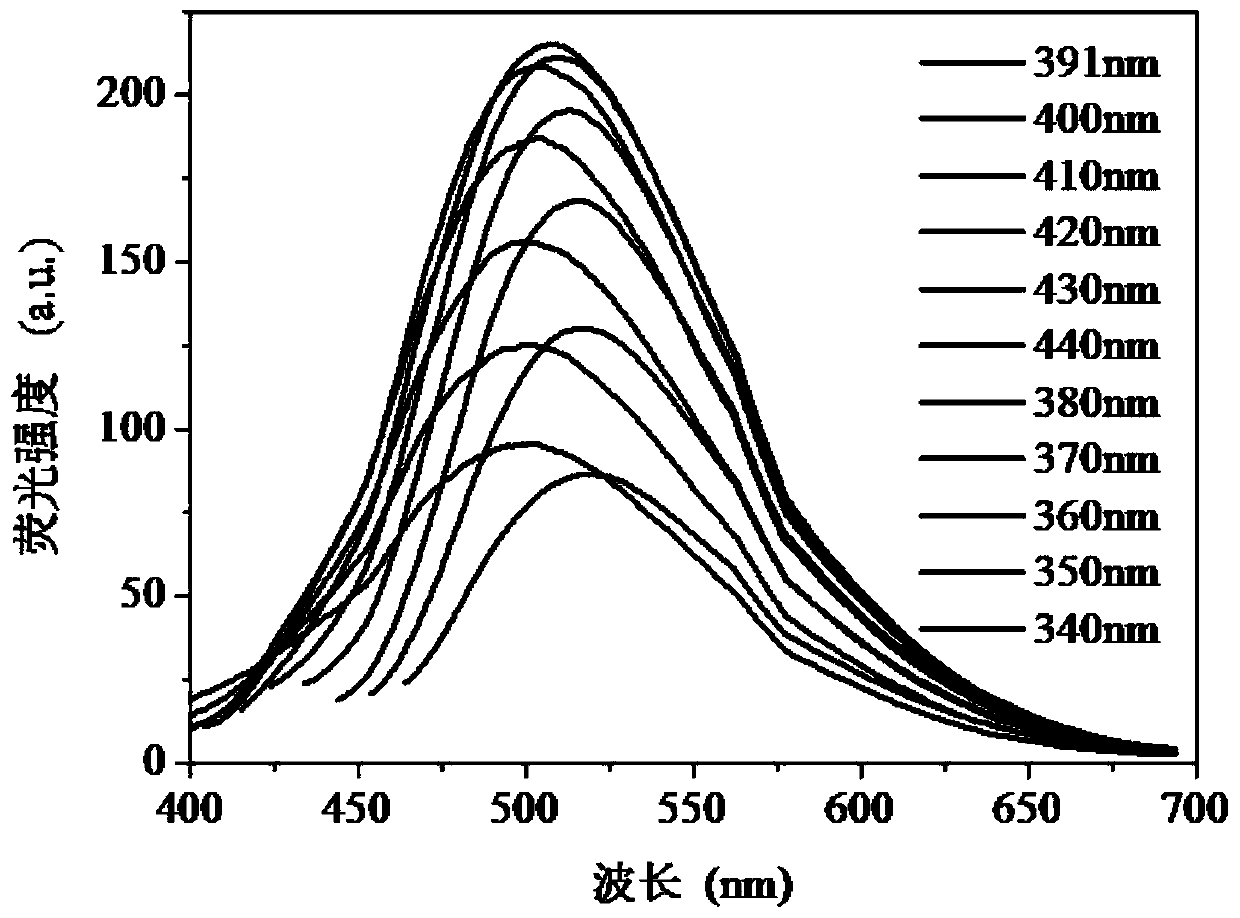Green fluorescent carbon quantum dot for detecting pH of acid environment and preparation method thereof
A technology of carbon quantum dots and green fluorescence, which is applied in the field of green fluorescent carbon quantum dots and its preparation, can solve the problems of unfriendly solvents, limited applications, and long time consumption, and achieve good water solubility and biocompatibility. Preparation method Simple, responsive effect
- Summary
- Abstract
- Description
- Claims
- Application Information
AI Technical Summary
Problems solved by technology
Method used
Image
Examples
Embodiment 1
[0028] Preparation method of carbon quantum dots:
[0029] (1) Add 0.1081g of p-phenylenediamine, 195uL of phosphoric acid, and 96uL of ethylenediamine, dissolve in 5mL of secondary water, stir thoroughly and ultrasonically dissolve for 15 minutes;
[0030] (2) Put it into a microwave oven (1000w) and heat it for 3min10s;
[0031] (3) After cooling, add 5ml of ultrapure water and ultrasonically dissolve it; filter the product with filter paper and microfiltration membrane (0.22 μM) to remove macromolecular particles; centrifuge to obtain a dark brown solution, and freeze-dry the solution to obtain a dry brown powder. The relative quantum yield of the obtained carbon quantum dots was 2.6%.
[0032] Characterize the carbon quantum dots synthesized above:
[0033] Transmission electron microscope image of carbon quantum dots figure 1 . The carbon quantum dots present monodisperse spherical particles in morphology, and the particle diameter is about 1.35nm.
[0034] carbon qu...
Embodiment 2
[0042] (1) Add 0.1081g of p-phenylenediamine, 195μL of phosphoric acid, and 96μL of ethylenediamine, dissolve in 5mL of secondary water, stir thoroughly and ultrasonically dissolve for 15 minutes;
[0043] (2) Put it into a microwave oven (1000w) and heat it for 1min30s;
[0044] (3) After cooling, add 5mL of ultrapure water and ultrasonically dissolve it. The product was filtered with filter paper and microfiltration membrane (0.22 μM) to remove macromolecular particles. Centrifugation gave a dark brown solution, which was lyophilized to give a dry brown powder.
[0045] Compared with the carbon quantum dots obtained in Example 1, the obtained carbon quantum dots had an obvious blue shift in wavelength, and the relative quantum yield was 1.1%.
Embodiment 3
[0047](1) Add 0.1081g of p-phenylenediamine, 195μL of phosphoric acid, and 96μL of ethylenediamine, dissolve in 5mL of secondary water, stir thoroughly and ultrasonically dissolve for 15 minutes;
[0048] (2) Put it into a microwave oven (1000w) and heat it for 3min 40s;
[0049] (3) After cooling, add 5mL of ultrapure water and ultrasonically dissolve it. The product was filtered with filter paper and microfiltration membrane (0.22 μM) to remove macromolecular particles. Centrifugation gave a dark brown solution which was lyophilized to give a dry powder.
[0050] Compared with the carbon quantum dots obtained in Example 1, the obtained carbon quantum dots have no obvious change in wavelength and relative quantum yield, but it takes a long time and wastes resources.
PUM
| Property | Measurement | Unit |
|---|---|---|
| particle diameter | aaaaa | aaaaa |
Abstract
Description
Claims
Application Information
 Login to View More
Login to View More - R&D
- Intellectual Property
- Life Sciences
- Materials
- Tech Scout
- Unparalleled Data Quality
- Higher Quality Content
- 60% Fewer Hallucinations
Browse by: Latest US Patents, China's latest patents, Technical Efficacy Thesaurus, Application Domain, Technology Topic, Popular Technical Reports.
© 2025 PatSnap. All rights reserved.Legal|Privacy policy|Modern Slavery Act Transparency Statement|Sitemap|About US| Contact US: help@patsnap.com



